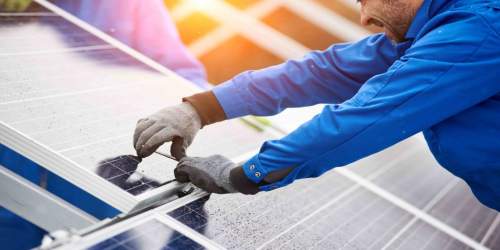Read Time : 6 Minutes
Solar Panels for Schools and Colleges
The UK is committed to reaching Net Zero by 2050. Schools and colleges can play an important part in achieving this goal by using the renewable energy of the sun and solar PV technology to power them.
Although installing solar power in educational institutions has become an increasingly popular option due to its many benefits currently only one-fifth of the UK’s school estate would likely be net-zero compliant by 2050. This presents a big challenge for the coming decades.
The UK’s Department for Education (DFE) has pledged to produce a detailed roadmap to net zero for nurseries, schools, and colleges by the autumn of 2024.
Most schools have quite large premises and will require a lot of solar panels to power them without help from the grid. Schools can use up to 10 kWh of electricity per square foot annually. Even offsetting this slightly can be beneficial.
Just as businesses benefit from commercial solar, schools, and colleges can also benefit from a solar panel system in numerous ways. Not only can solar panels for schools reduce electricity bills and carbon emissions but they can also add value to a school’s facilities.
COMPARE PRICES FROM LOCAL INSTALLERS
Compare prices from local companies fast & free
Enter your postcode to compare quotes from leading professionals. We promise to keep your information Safe & Secure. Privacy Policy
The Benefits of Solar Panels for Schools and Colleges
Lower bills
By installing solar panels schools can make significant savings on their electricity bills freeing up funds for educational and recreational programmes. Solar PV can be used to power classrooms, administrative offices, and outdoor lighting. High-quality solar panels can generate electricity for more than 40 years which means the cost savings are likely to be substantial over a long period of time. Though most affordable domestic solar panel systems cannot power a whole school without a very large array, even a more modest setup can decrease costs.
Reduce CO2 emissions and carbon footprint
Installing solar panels can help schools significantly lower their carbon emissions and reduce their carbon footprint. This is a great way for schools to support climate action and play an important role in reaching net zero by 2050. A medium-sized system can reasonably expect to mitigate several tonnes of greenhouse gas emissions each year making meaningful CO2 savings over the lifespan of a system.
Demonstrate a commitment to sustainability via education and engagement
Installing solar panels can provide a valuable educational opportunity for students to learn about the advantages of sustainability through a working example of renewable technology in their school. This will allow for more direct engagement, particularly in the subjects of geography, science, design and technology, and IT. This could also have far-reaching effects on the wider community inspiring them to take action to address climate change.
Revenue from the sale of surplus power
Excess energy can be sold back to the grid during holidays through power companies. Schools can negotiate a deal with their energy provider for this excess energy and generate additional revenue for school programmes or infrastructure projects. How much a school can earn will be determined by the size and efficiency of its system, the capital cost of the system, and what tariff the school has opted for with its energy provider.
Protection from future increases in energy costs
Solar panels can offer a reliable, long-term energy solution for schools that frees them from traditional energy providers and all the turbulence of price hikes, failing infrastructure, and potential power cuts that reliance on them entails. With the right installation solar panels can provide free electricity for over 25 years creating a competitive advantage for schools and protecting them from future increases in energy prices. Solar panels can produce enough energy to pay back installation costs within 6-8 years.
Financing options are available to make solar for schools more affordable
There are several different funding options such as grants, including government grants, incentives, interest-free loans, Salix loans, and Power Purchase Agreements that can make solar panel installation more affordable for schools.
The Cost of Solar Panels for Schools and Colleges
The cost of installing a photovoltaic system for a school or college varies depending on a number of factors such as the size of the system needed, the location of the school, and the types of solar panels and inverters used. Standard systems for schools in the UK can cost from £10,000 to £5,000 or more.
While the cost of installation of solar PV for a school or college may seem high, a solar PV system offers a wealth of benefits not least of which are the significant cost savings and the provision of a long-term energy solution. Fortunately, there are some funding options available.
It’s best to consult with 3 or 4 reputable solar panel installers to get a more accurate estimate of the cost of solar panels for a school or college. You can use our tool to find reputable and professional installers here: https://www.renewableenergyhub.co.uk/search-installers
Batteries for Schools
It is possible to install battery storage in schools, which can function as a further exemplar of green technology to the students. However, because schools are mainly in use during the day, they can benefit directly from solar without the need for a battery. In most cases, it is hard to create a financial case for batteries in schools, so this is very much a ‘nice-to-have’ should funds be available.
The Installation Process
Before a solar panel system can be installed for a school or college several permit requirements must be met. These permits must be obtained from the local authority as well as any other relevant authorities. Having solar panels fitted is a straightforward process and shouldn’t cause any disruption to the school’s working day. Even if it isn’t possible to organise the installation outside of term time students and teachers should be able to move around the site without any risk. The installation process is quick and depending on the size of the solar installation should usually be completed within a couple of days.
Solar Panel Maintenance
Schools should implement a maintenance checklist to ensure that their solar panel system is in working order. Here are some items to check to identify any potential risks:
1. Clean the panels and surrounding area to remove any dust, debris, or other materials.
2. Inspect the panels regularly to identify any scratches, cracks, or potential hazards.
3. Monitor the performance of the system to identify any anomalies.
4. Test the panels to make sure they are operating at maximum efficiency.
If proper maintenance is conducted and any corrective action needed is taken, schools can be confident that their solar panel systems will operate at their best for many years to come.
Current Incentives and Subsidies
Many schools and colleges won’t have ample funds to cover the cost of installing a solar panel system. However, just as with commercial solar, there are a large number of initiatives available to help cover the costs of solar PV installation for schools and colleges. These incentives can make solar panel installation more affordable for schools and reduce their energy costs. These significant savings can lead to funds being redirected to curricular resources and facilities.
Here are some of the incentives and subsidies available:
National Government Incentives and Grants
the UK government runs initiatives to help companies improve energy efficiency. These programmes change often, so it’s a good idea to check out the latest updates to find out what programmes are available. As well as grants, loans, and other funding options they also run longer-term incentives.
Salix Finance Ltd
Salix Finance Ltd delivers government funding to the public sector, including central government, to improve energy efficiency, reduce carbon emissions, and lower energy bills. The Salix Finance Scheme provides interest-free loans to public sector organisations for energy efficiency projects.
It is an executive non-departmental public body, sponsored by the Department for Energy Security and Net Zero.
Since its formation in 2004 up to 31 March 2023, Salix has helped public sector organisations like schools and colleges commit to more than 22,000 projects by administering £3.3 billion of funding, with projects saving 1.1 million tonnes of carbon dioxide annually.
The Energy Efficacy Financing (EEF) and Power Purchase Agreement programmes
In some cases, projects can be 100% funded with a solar panel grant or heavily discounted with a smaller contribution being needed towards the cost. When the system is in place and operational, schools quickly notice the reduced electricity costs and utility bills that help to offset the initial investment.
Through the terms of a Power Purchase Agreement, schools, academies, and other higher education institutions can benefit from free solar panels. These will be fitted by qualified and professional installers to allow electricity to be generated and are then sold back to eligible customers at a cheaper rate than the National Grid.
Smart Export Guarantee (SEG)
The Smart Export Guarantee (SEG) is a commitment to buy excess energy generated by private solar systems. SEG is the replacement for the government’s Feed in Tariff (FIT). FIT, although closed to new applications is a popular scheme still running today. Excess energy can be sold back to the grid during holidays through power companies. Schools can negotiate a deal with their energy provider for this excess energy and generate additional revenue for school programmes or infrastructure projects.
ZERO VAT Commitment
This scheme waives VAT on the installation of solar energy systems.
Local Community Schemes
Community energy groups raise finance within their local community to pay for the solar installation, so the school does not have to spend a penny. The electricity produced is then sold to the school at a subsidised rate. So, if the school was paying 12p/kWh for their electricity, the community group would sell power to the school for about 9p/kWh, giving the school immediate bill savings of 25%. Selling the electricity to the school in this way is enough to pay back the investors over time. It also generates a small surplus over time that can fund further environmental projects within the local area.
The Schools’ Energy Co-operative
The Schools’ Energy Co-operative installs community-funded solar panel systems on schools free of charge as well as paying all its profits to its member schools.
The Wey Valley Solar Schools Co-operative
The Wey Valley Solar Schools Co-operative (Wey Valley Solar) is a community-owned energy co-operative set up by local people from the towns of Guildford and Godalming in Surrey. In 2011 we started with 238 kW of solar panels on the roofs of six state secondary schools in Surrey. This Co-operative provides each of their schools and community organisations with:
- renewable energy discounted to the school at a fixed price for the duration of the contract helping schools manage and reduce their energy costs
- a share of any surplus generated by the co-op. None of the co-op’s directors are paid
The Low-Carbon Hub
The Low-Carbon Hub develops community-owned renewable energy installations for organisations such as schools across Oxfordshire that not only produce clean energy but accelerate the transition to the zero-carbon energy system we need for the future, providing electricity, heat, and a clean transport system, all-powered by renewables. The installations also produce an ongoing income, which is reinvested in further carbon-cutting projects.
Egni Co-operative
Egni Co-op develops rooftop solar energy in Wales and has nearly 5 MWp of capacity over 90 sites, including schools, community buildings, and businesses. They’re the largest rooftop solar Co-op in the UK. All surplus goes into climate education in schools.
Conclusion
There are many benefits for schools and colleges that choose to install solar PV. As well as the considerable cost savings to be made, installing solar PV gives schools and colleges the chance to play a role in helping to reach climate change targets and reduce their carbon footprint. It will also improve the public image of schools and colleges as they will be seen to be environmentally responsible.
Solar panels will ensure a reliable energy supply for 25 years or more due to their durability and low maintenance requirements. It has become increasingly clear that solar energy can protect schools from the volatility of the energy markets by giving them energy independence.
While energy prices remain high, the payback period for solar continues to become shorter making installing solar PV a smart long-term financial investment.
The Carbon Trust estimates that UK schools, as a whole, could save £44 million per year and offset 625,000 tons of CO2 by implementing energy efficiency measures like solar PV panels. With the right incentives, solar panels can be a cost-effective and environmentally friendly solution for schools.
Find a local installer
Welcome to the biggest directory of UK renewable energy companies





 How Much do Solar Panel Systems Cost in 2024?
How Much do Solar Panel Systems Cost in 2024?







